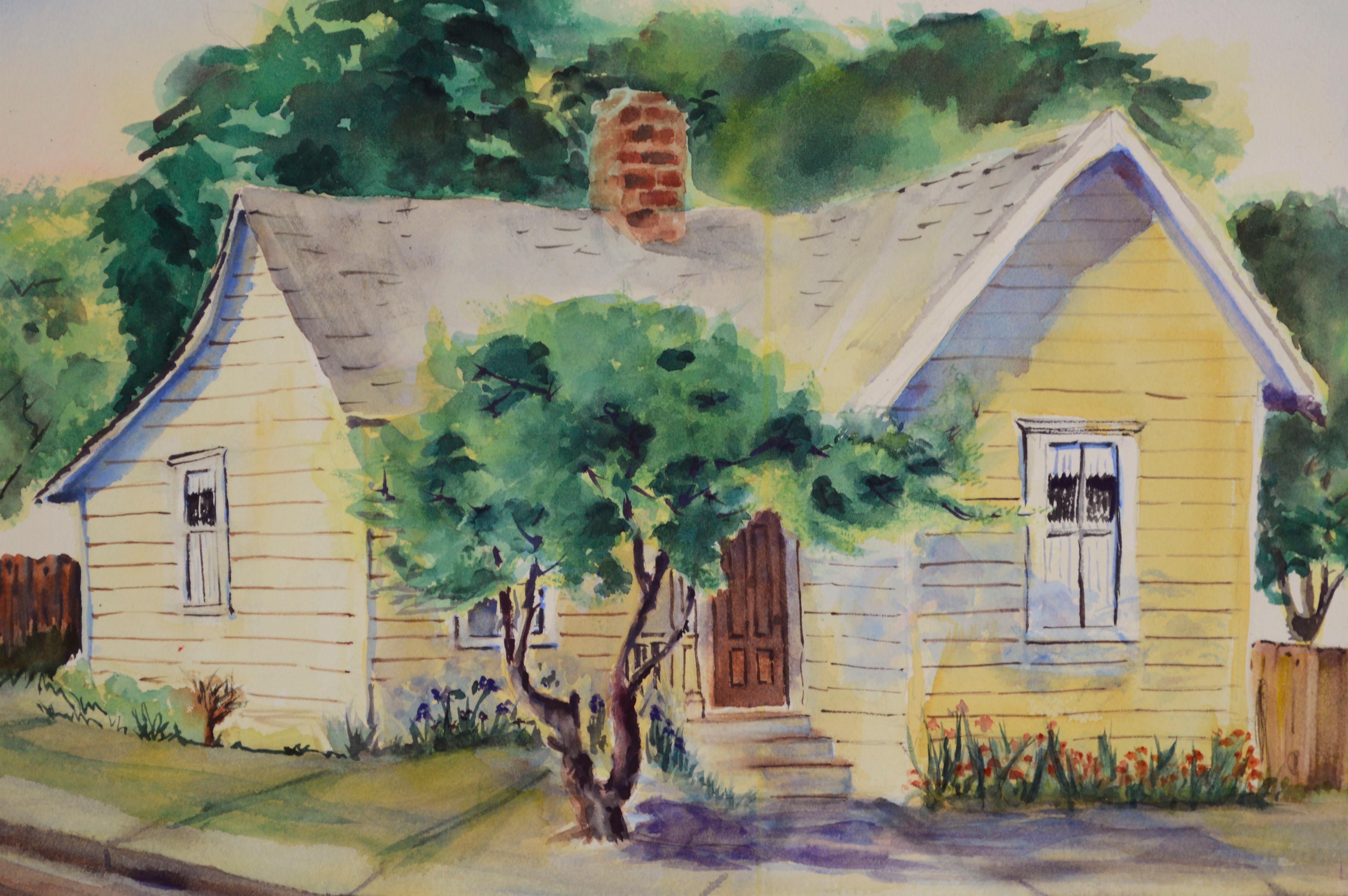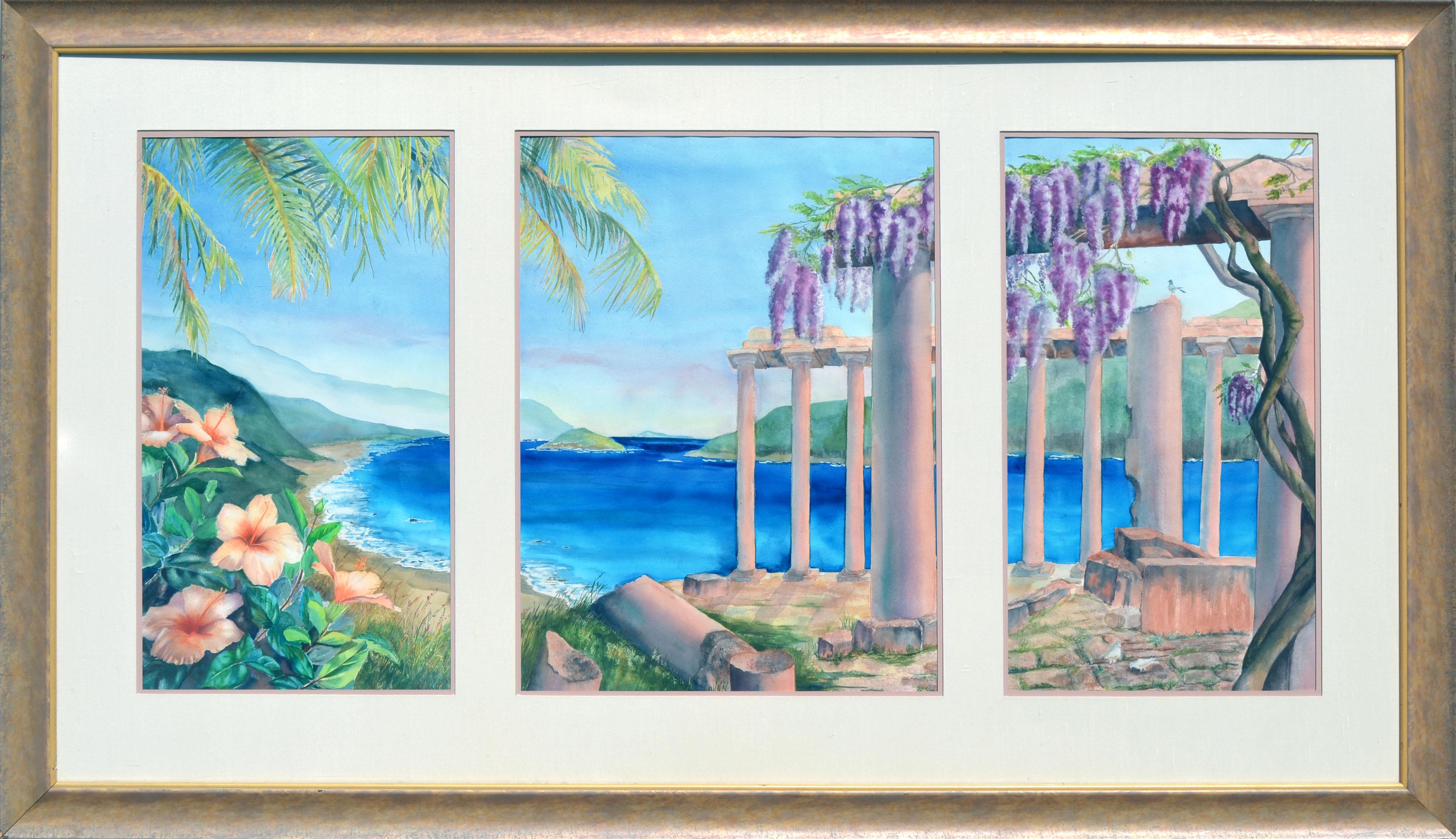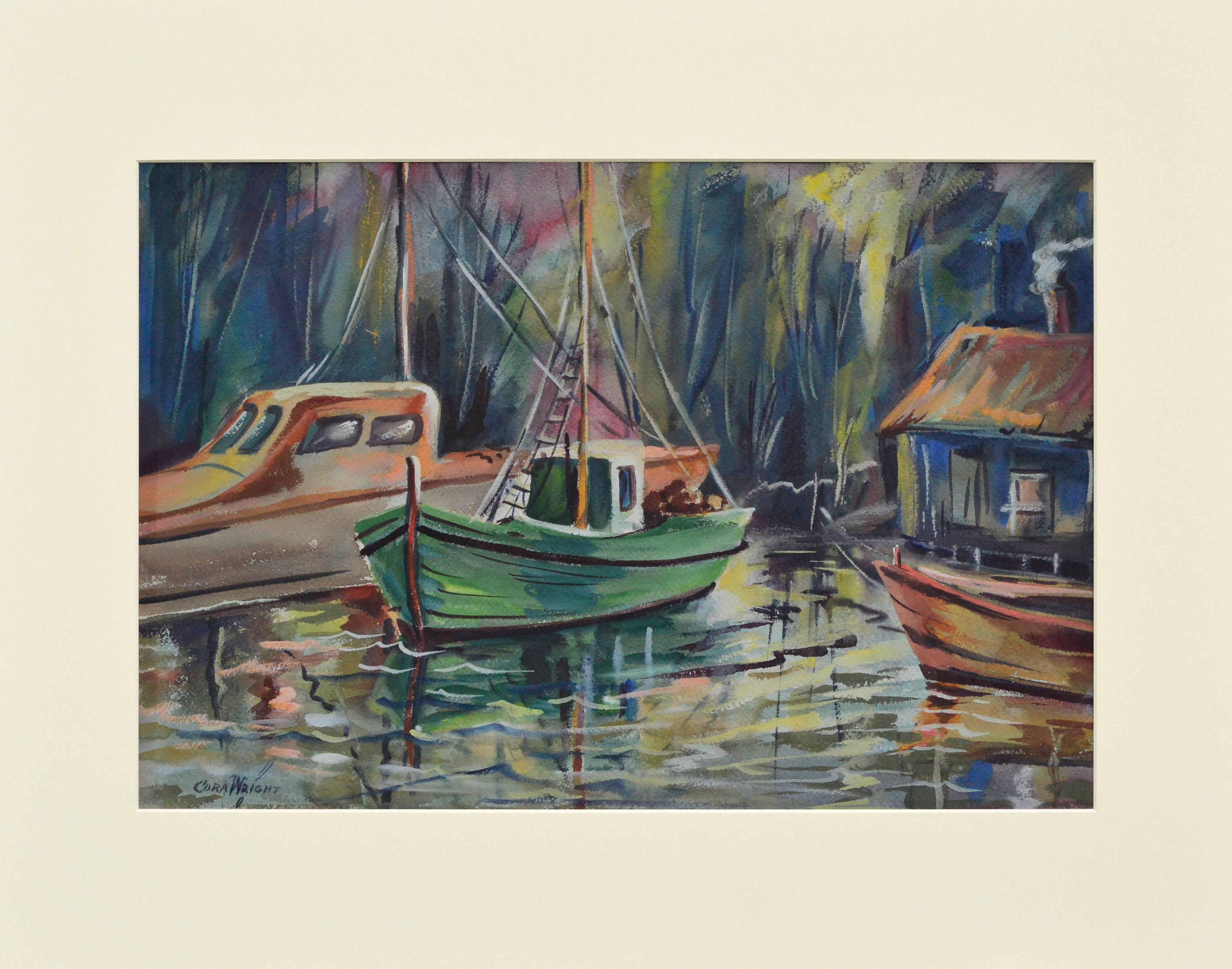Items Similar to Ship at Sea / Winter Landscape, Mid Century Double-Sided Watercolor
Want more images or videos?
Request additional images or videos from the seller
1 of 8
Lillie HeebnerShip at Sea / Winter Landscape, Mid Century Double-Sided Watercolor
About the Item
Double sided watercolor painting of a ship off the Santa Cruz, California coast and a path through the snow covered mountains on verso by Lillie Esther (Hillman) Heebner (American, 1923-2016), a Watsonville, Monterey Bay area, California watercolor artist. Unsigned, but acquired with a collection of her work.
Lillie (Lil) E. Heebner was guided through life by her creativity. Even at 92, she never felt old, and often said so. She met every situation in life—including death—with ingenuity.
Although born in Richmond, Lillie lived in Watsonville all her life. Her father, Frederick H. Hillman, grew up on a strawberry ranch in Pajaro, graduated from Watsonville High School in 1916, and served in France during World War I. He later worked for Martinelli's Apple Cider plant and became foreman. Lillie's mother, Esther C. Hobson, moved as an infant from Bakersfield to Santa Cruz with her family in 1901, when they founded Hobson's Bath House at the Santa Cruz Boardwalk. Other family members had lived in this region since the 1880s, settling in Soquel and Santa Clara.
Lillie graduated from Watsonville High School in 1941, enrolled at Hartnell College in Salinas, and worked as a window dresser at Ford's Department Store during World War II. Invited to a dinner with Fort Ord soldiers as guests, she was introduced to Richard (Dick) Heebner of Oregon City, Oregon. Dick and Lillie met on Christmas and were married Easter Sunday, April 9, 1944, at All Saint's Episcopal Church. They both remained active and devoted members of All Saint's, celebrating their 50th wedding anniversary there in 1994.
Always blessed with friends, Lillie enjoyed lifelong connections in Watsonville and in La Selva Beach, where the family lived for eight years. She had varied interests, but most enjoyed the arts. In her middle years, Lillie studied watercolor painting with artists George Bowman and Bernie Waymire, and enjoyed her latest classes with Bonni Carver. She sold her artwork as a member of the Pajaro Valley Artist's Association.
- Creator:Lillie Heebner (American)
- Dimensions:Height: 13 in (33.02 cm)Width: 20 in (50.8 cm)Depth: 1 in (2.54 cm)
- Medium:
- Movement & Style:
- Period:
- Condition:Normal age toning to perimeter of paper.
- Gallery Location:Soquel, CA
- Reference Number:
About the Seller
4.9
Platinum Seller
These expertly vetted sellers are 1stDibs' most experienced sellers and are rated highest by our customers.
Established in 1986
1stDibs seller since 2014
2,542 sales on 1stDibs
Typical response time: <1 hour
- ShippingRetrieving quote...Ships From: Soquel, CA
- Return PolicyA return for this item may be initiated within 14 days of delivery.
More From This SellerView All
- Show Me Home - Double Sided WatercolorBy Les AndersonLocated in Soquel, CAA beautiful double sided watercolor painting of a vibrant yellow house surrounded by green trees with a landscape painting of houses on the green hillside with faded mountaintops in ...Category
Mid-20th Century American Impressionist Landscape Paintings
MaterialsWatercolor, Paper
- Minimalist Mid Century Modern Landscape -- Autumn TreesLocated in Soquel, CAMinimalist mid-century modern landscape of three autumnal trees by M. Lehtio (American, 20th century). Signed "M. Lehtio" and dated "48." Presented in a wood frame and non-glare glas...Category
1940s American Impressionist Landscape Paintings
MaterialsWatercolor, Laid Paper
- Mid Century Tonalist Landscape of California Country RoadLocated in Soquel, CABeautiful tonalist landscape of California foothills and country road. Signed and dated "CKP" and "'69" lower right corner. Presented in rustic wood frame with eggshell mat under nonglare glass. Image size: 18.25"H x 13.25"W. Framed size: 23.5"H x 18"W. California Tonalism was art movement that existed in California from circa 1890 to 1920. Tonalist are usually intimate works, painted with a limited palette. Tonalist paintings are softly expressive, suggestive rather than detailed, often depicting the landscape at twilight or evening, when there is an absence of contrast. Tonalist paintings could also be figurative, but in them, the figure was usually out of doors or in an interior in a low-key setting with little detail. Tonalism had its origins in the works of the French Barbizon school and in the works of American painters who were influenced by them. California Tonalism was born when the emphasis in California landscape painting passed from the grand landscapes of works like those of Thomas Hill and William Keith's early career, to more intimate views of a domesticated landscape. At the same time, the parallel Pictorialist Photography...Category
1960s American Impressionist Landscape Paintings
MaterialsGouache, Laid Paper
- Large Scale Triptych Watercolor Landscape -- Paradise CoveLocated in Soquel, CAA secluded ancient site with lush foliage overlooking a brilliant blue cove is the subject of this watercolor triptych combined in single framing by artist Isabel McCauley...Category
1990s American Impressionist Landscape Paintings
MaterialsWatercolor, Laid Paper
- Mid Century Fishing Boats LandscapeLocated in Soquel, CAVibrant watercolor of three fishing boats by Cora Alice Akers Wright (American, 1908-1992). which are anchored in a small body of water. Signed...Category
Early 20th Century American Impressionist Landscape Paintings
MaterialsWatercolor, Laid Paper
- California Wetland Ponds Landscapes (Two Sided)Located in Soquel, CAWonderful two sided landscape of California wetlands with pond. Circa 1960s. Monogramed. Image size: 19"H x 25"W. Presented in wood frame. Frame size: 19"H x 25"W. One side Meadow ...Category
1990s American Impressionist Landscape Paintings
MaterialsWatercolor, Laid Paper
You May Also Like
- "Train Station, " Max Kuehne, Industrial City Scene, American ImpressionismBy Max KuehneLocated in New York, NYMax Kuehne (1880 - 1968) Train Station, circa 1910 Watercolor on paper 8 1/4 x 10 1/4 inches Signed lower right Provenance: Private Collection, Illinois Max Kuehne was born in Halle, Germany on November 7, 1880. During his adolescence the family immigrated to America and settled in Flushing, New York. As a young man, Max was active in rowing events, bicycle racing, swimming and sailing. After experimenting with various occupations, Kuehne decided to study art, which led him to William Merritt Chase's famous school in New York; he was trained by Chase himself, then by Kenneth Hayes Miller. Chase was at the peak of his career, and his portraits were especially in demand. Kuehne would have profited from Chase's invaluable lessons in technique, as well as his inspirational personality. Miller, only four years older than Kuehne, was another of the many artists to benefit from Chase's teachings. Even though Miller still would have been under the spell of Chase upon Kuehne's arrival, he was already experimenting with an aestheticism that went beyond Chase's realism and virtuosity of the brush. Later Miller developed a style dependent upon volumetric figures that recall Italian Renaissance prototypes. Kuehne moved from Miller to Robert Henri in 1909. Rockwell Kent, who also studied under Chase, Miller, and Henri, expressed what he felt were their respective contributions: "As Chase had taught us to use our eyes, and Henri to enlist our hearts, Miller called on us to use our heads." (Rockwell Kent, It's Me O Lord: The Autobiography of Rockwell Kent. New York: Dodd, Mead and Co., 1955, p. 83). Henri prompted Kuehne to search out the unvarnished realities of urban living; a notable portion of Henri's stylistic formula was incorporated into his work. Having received such a thorough foundation in art, Kuehne spent a year in Europe's major art museums to study techniques of the old masters. His son Richard named Ernest Lawson as one of Max Kuehne's European traveling companions. In 1911 Kuehne moved to New York where he maintained a studio and painted everyday scenes around him, using the rather Manet-like, dark palette of Henri. A trip to Gloucester during the following summer engendered a brighter palette. In the words of Gallatin (1924, p. 60), during that summer Kuehne "executed some of his most successful pictures, paintings full of sunlight . . . revealing the fact that he was becoming a colorist of considerable distinction." Kuehne was away in England the year of the Armory Show (1913), where he worked on powerful, painterly seascapes on the rocky shores of Cornwall. Possibly inspired by Henri - who had discovered Madrid in 1900 then took classes there in 1906, 1908 and 1912 - Kuehne visited Spain in 1914; in all, he would spend three years there, maintaining a studio in Granada. He developed his own impressionism and a greater simplicity while in Spain, under the influence of the brilliant Mediterranean light. George Bellows convinced Kuehne to spend the summer of 1919 in Rockport, Maine (near Camden). The influence of Bellows was more than casual; he would have intensified Kuehne's commitment to paint life "in the raw" around him. After another brief trip to Spain in 1920, Kuehne went to the other Rockport (Cape Ann, Massachusetts) where he was accepted as a member of the vigorous art colony, spearheaded by Aldro T. Hibbard. Rockport's picturesque ambiance fulfilled the needs of an artist-sailor: as a writer in the Gloucester Daily Times explained, "Max Kuehne came to Rockport to paint, but he stayed to sail." The 1920s was a boom decade for Cape Ann, as it was for the rest of the nation. Kuehne's studio in Rockport was formerly occupied by Jonas Lie. Kuehne spent the summer of 1923 in Paris, where in July, André Breton started a brawl as the curtain went up on a play by his rival Tristan Tzara; the event signified the demise of the Dada movement. Kuehne could not relate to this avant-garde art but was apparently influenced by more traditional painters — the Fauves, Nabis, and painters such as Bonnard. Gallatin perceived a looser handling and more brilliant color in the pictures Kuehne brought back to the States in the fall. In 1926, Kuehne won the First Honorable Mention at the Carnegie Institute, and he re-exhibited there, for example, in 1937 (Before the Wind). Besides painting, Kuehne did sculpture, decorative screens, and furniture work with carved and gilded molding. In addition, he designed and carved his own frames, and John Taylor Adams encouraged Kuehne to execute etchings. Through his talents in all these media he was able to survive the Depression, and during the 1940s and 1950s these activities almost eclipsed his easel painting. In later years, Kuehne's landscapes and still-lifes show the influence of Cézanne and Bonnard, and his style changed radically. Max Kuehne died in 1968. He exhibited his work at the National Academy of Design, the Art Institute of Chicago, the Carnegie Institute in Pittsburgh, the Memorial Art Gallery of the University of Rochester, and in various New York City galleries. Kuehne's works are in the following public collections: the Detroit Institute of Arts (Marine Headland), the Whitney Museum (Diamond Hill...Category
1910s American Impressionist Landscape Drawings and Watercolors
MaterialsPaper, Watercolor
- Mount MonadnockBy Frank Weston BensonLocated in Milford, NHAn exceptional watercolor of Mount Monadnock snow capped in winter in New Hampshire by American artist Frank Weston Benson (1862-1951). Benson was born in Salem, Massachusetts and went on to study in Boston at the Museum School of Fine Arts and later with Julian Lefebvre and Gustave Boulanger at the Academie Julian in Paris. Benson was well known for his impressionist landscapes and seascapes, and etchings of hunting scenes. Watercolor on paper, signed lower left F.W. Benson with inscription “To Mrs Bush,” titled on Vose Galleries...Category
Early 20th Century American Impressionist Landscape Drawings and Waterco...
MaterialsPaper, Watercolor
- Canal at Indian Mound RoadBy Ben FenskeLocated in Sag Harbor, NYPainted during the 2015 Winter Equestrian Festival in Wellington, Florida. A black and white depiction of a canal, is barely recognizable, due to Fenske's wild brushstrokes and lack...Category
21st Century and Contemporary American Impressionist Landscape Paintings
MaterialsGouache, Paper
- "Monhegan Island, Maine, " Edward Dufner, American Impressionism Landscape ViewBy Edward DufnerLocated in New York, NYEdward Dufner (1872 - 1957) Monhegan Island, Maine Watercolor on paper Sight 16 x 20 inches Signed lower right With a long-time career as an art teacher and painter of both 'light' and 'dark', Edward Dufner was one of the first students of the Buffalo Fine Arts Academy to earn an Albright Scholarship to study painting in New York. In Buffalo, he had exchanged odd job work for drawing lessons from architect Charles Sumner. He also earned money as an illustrator of a German-language newspaper, and in 1890 took lessons from George Bridgman at the Buffalo Fine Arts Academy. In 1893, using his scholarship, Dufner moved to Manhattan and enrolled at the Art Students League where he studied with Henry Siddons Mowbray, figure painter and muralist. He also did illustration work for Life, Harper's and Scribner's magazines. Five years later, in 1898, Dufner went to Paris where he studied at the Academy Julian with Jean-Paul Laurens and privately with James McNeill Whistler. Verification of this relationship, which has been debated by art scholars, comes from researcher Nancy Turk who located at the Smithsonian Institution two 1927 interviews given by Dufner. Turk wrote that Dufner "talks in detail about Whistler, about how he prepared his canvasas and about numerous pieces he painted. . . A great read, the interview puts to bed" the ongoing confusion about whether or not he studied with Whistler. During his time in France, Dufner summered in the south at Le Pouleu with artists Richard Emil Miller...Category
Early 20th Century American Impressionist Landscape Drawings and Waterco...
MaterialsPaper, Watercolor
- Bali LandscapeLocated in Columbia, MOBenjamin Cameron spent 48 years teaching students in Columbia across three different colleges. His own works still hang on the walls around the community and tell a greater story of ...Category
21st Century and Contemporary American Impressionist Landscape Paintings
MaterialsWatercolor, Archival Paper
- Southern LandscapeLocated in Milford, NHA fine gouache painting of a Southern landscape by American artist Beatrice Lavis Cuming (1903-1975). Cuming was born in Brooklyn, NY, studied lo...Category
Mid-20th Century American Impressionist Landscape Paintings
MaterialsPaper, Gouache
Recently Viewed
View AllMore Ways To Browse
Mid Century Friends
All Saints Vintage
Mid Century Ranch
Mid Century Ship Painting
American Carver
Santa Cruz Mountains
Christmas Window
Blessed Vintage
Vintage Beach Cover Up
Christmas Snow
Monterey Coast
Death Valley California
Retro Beach Cover Up
Vintage Easter Paper
Old Vintage Dresser
Midcentury Easter
Apple Ii
Vintage Christmas Santa





